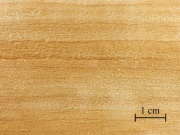Difference between revisions of "Aspen"
(username removed) |
JMcGlinchey (talk | contribs) |
||
| Line 25: | Line 25: | ||
| specific gravity = 0.45 | | specific gravity = 0.45 | ||
|} | |} | ||
| + | |||
| + | Paper fiber type: hardwood, diffuse porous. Using transmitted light microscopy, pulp is identified by medium to long vessels with alternate crowded pitting on one side. Ray parenchyma pits are alternate and occur in horizontal groups. Perforations are simple. Appearance with [[Graff "C" stain]]: dark blue, but varies with bleaching. Average dimensions of fibers: length, 0.9mm. 19μm wide. Common pulping method: [[kraft process|kraft]]. | ||
== Additional Information == | == Additional Information == | ||
Revision as of 14:57, 13 July 2015
Description
A deciduous hardwood tree of the willow family, such as Populus tremula (European quaking aspen), P. tremuloides (American quaking aspen) and P. alba (white aspen). Aspen trees are native to northern Europe, Asia and North America. The fast-growing aspen trees have a smooth, pale gray bark and circular leaves with toothed edges. The soft, yellowish-white timber has a uniform, straight grain with almost no distinction between the summerwood and springwood. Aspen poplar wood has large, evenly-distributed pores that produce a soft fibrous texture. It cannot be planed smooth. Aspen wood is easy to work, but weak, prone to warping and produces a disagreeable odor when wet. The lightweight, spongy wood is generally used for matches, excelsior, fruit boxes and paper pulp.
Synonyms and Related Terms
Populus tremula; Populus tremuloides; Populus alba; peuplier tremble (Fr.); Espe (Deut.); Pappel (Deut.); Zitterpappel (Deut.); pioppo tremula (It.); alamo temblon (Esp.); cran critheach (Gaelic); choupo (Port.); aspen poplar; trembling aspen; trembling poplar; quivering aspen; shaking aspen; popple
Other Properties
Freshly cut wood is full of sap and will not float and will not burn.
Light colored. Rings: obscure. Pores:large. Grain:invisible. Rays:obscure. Soft; lightweight; spongy
| Density | 28 ppcf |
|---|---|
| Molecular Weight | specific gravity = 0.45 |
Paper fiber type: hardwood, diffuse porous. Using transmitted light microscopy, pulp is identified by medium to long vessels with alternate crowded pitting on one side. Ray parenchyma pits are alternate and occur in horizontal groups. Perforations are simple. Appearance with Graff "C" stain: dark blue, but varies with bleaching. Average dimensions of fibers: length, 0.9mm. 19μm wide. Common pulping method: kraft.
Additional Information
° Schoch, W., Heller, I., Schweingruber, F.H., Kienast, F., 2004:Wood anatomy of central European Species: Aspen, Populus tremula L.
Authority
- H.L.Edlin, What Wood is That?, Viking Press, New York, 1969
- G.S.Brady, Materials Handbook, McGraw-Hill Book Co., New York, 1971 Comment: p. 75
- Van Nostrand's Scientific Encyclopedia, Douglas M. Considine (ed.), Van Nostrand Reinhold, New York, 1976
- Random House, Webster's Encyclopedic Unabridged Dictionary of the English Language, Grammercy Book, New York, 1997
- The American Heritage Dictionary or Encarta, via Microsoft Bookshelf 98, Microsoft Corp., 1998
- Gordon Hanlon, contributed information, 1998

